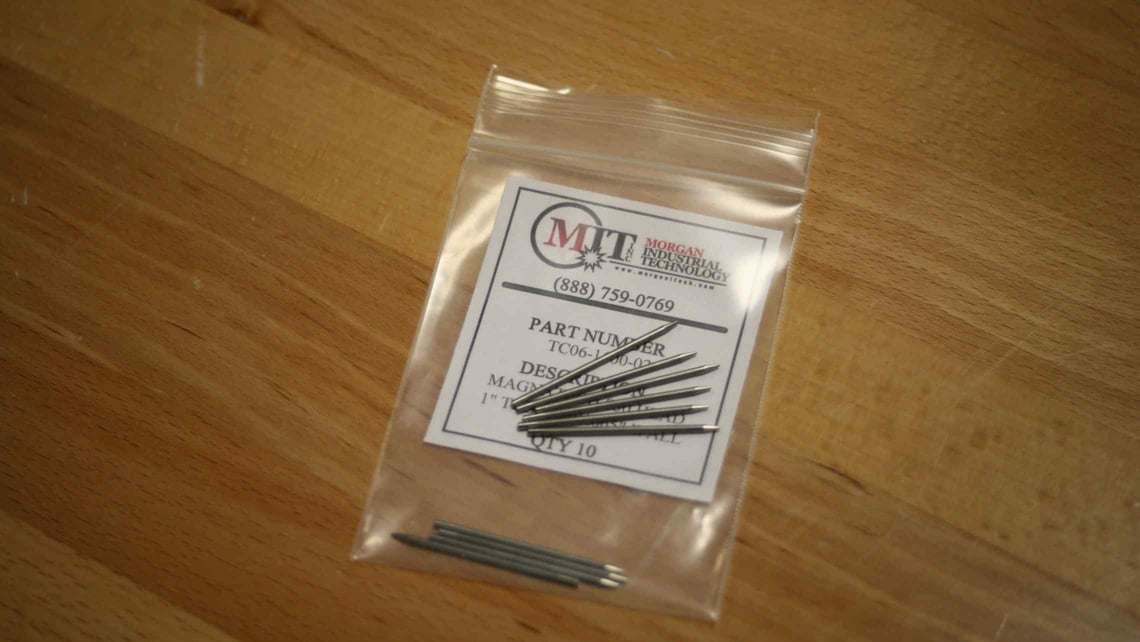
Orbital Tungsten
GTAW (Gas Tungsten Arc Welding), otherwise known as TIG (Tungsten Inert Gas) welding, uses tungsten as an electrode to direct an electrical current in order to strike an arc.
Orbital welding automates the process of TIG welding on tube and pipe. Instead of hand welding, you can use a weld head and power supply to create the weld. A piece of tungsten is placed in the orbital weld head and keeps a consistent arc gap between the end of the tungsten and the tube or pipe as it performs a revolution or orbit.

MIT Tungsten
To manufacture the correct size of tungsten, there are three things that must be known: the tube or pipe being welded, the wall thickness, and what weld head is being used. This information is reflected in the part number for each size of tungsten. Let’s look at an example.
The part number TC06-0870-03 is tungsten used to weld 2.5” tube with a wall thickness of .065 when you are using the AMI 9-2500 weld head. The “TC” stands for the 2% Ceriated Tungsten that MIT uses. Ceriated tungsten is the best material to use for orbital welding applications.
The “06” stands for the OD of the tungsten in hundredths of an inch (.06”). The OD of the tungsten may change depending on the wall thickness of the tube/pipe. The heavier the wall, the more heat it will take to make a successful weld. A larger piece of tungsten (.09”) will endure the heat much better than a smaller piece (.06”).
The “0870” represents the length of the tungsten (0.870”). If you know the weld head being used and the OD of the tube or pipe, you can cut a piece of tungsten to maintain a specific arc gap. Usually, the arc gap is between .030” and .070”. The tungsten should be close to the weld in order to get adequate penetration. More importantly, the arc gap should remain consistent to achieve a uniform weld. The more variables you can control, the more consistent your welds can be.
The “03” stands for the diameter of the tip in hundredths of an inch (.03”). Tungsten is shaped like a pencil, but it should not come to a sharp point. Instead, the very end of the tip should be cut off to create a blunt end. This is important because studies show that having the tip cut off helps concentrate the arc on the weld and reduces the chances of arc outs.
The Difference in Ceriated Tungsten
Tungsten is available at your local welding store and even online platforms - so what makes MIT tungsten different? We start off by using the highest quality material available. We use 2% Ceriated Tungsten that meets ANSI/AWS A5.12-98 tungsten standards. All MIT tungsten is custom-cut, precision-ground, and super-polished in house.
Some tungsten manufacturers use a grinding wheel where the lines run the circumference of the tungsten. The angle on the end of MIT tungsten is hand ground with the grain running longitudinally. This helps prevent arc outs and other weld failures. Each piece is also ground within ½ of a degree of the desired angle. We also polish each piece to seal up the grind lines. This helps increase the life of each piece of tungsten. The results of these actions include consistency, better welds, longer life, and lower cost per weld.
When you are welding critical pieces, such as a $200 fitting, you should not risk the possibility of a bad weld due to tungsten. Take steps in choosing the right tungsten for your application and recognize the signs in changing out your tungsten. Learn more about choosing and changing tungsten electrodes.
With MIT ceriated tungsten electrodes, you will be able to see the cost of each weld decrease. Contact us at 417-485-4575 to order custom MIT tungsten electrodes.
Aug 20, 2020 12:00:00 AM

.png)
Comments